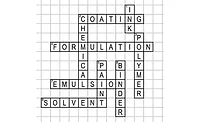Lindsay’s Honeycomb Pattern Answer

Laurence Dutton / Vetta, via Getty Images
In our August issue, we learned that Lindsay Doyle formulated an industrial primer using an alkyd-amino system pigmented with TiO2 and carbon black. Her testing indicated that the formulation met all the customer specifications. However, when tested by Saul Vance, the gloss reading decreased due to the occurrence of a hexagonal honeycomb pattern on the surface. Saul had only modified the formulation with the addition of some ketone solvent. He also eliminated the flash time before baking the panel in the oven. What was the cause of the honeycomb pattern and how was Saul going to solve the problem?
Saul Vance recognized the honeycomb pattern on the surface of the coating as Bénard cells. Bénard cells form in solvent-based coating films when there is a temperature gradient between the substrate (high temperature) and the surface (lower temperature). This temperature gradient causes convection currents in the coating. When the temperature gradient reaches a critical value, the flow pattern of the system suddenly changes. Solvent rises through the film to the surface, where evaporation occurs, resulting in cooling, viscosity build, and increasing surface tension. As the viscosity rises and the density increases, the material flows back into the film, down to the hot substrate surface, where the cycle repeats. The surface tension change also impacts the movement of the currents in the cells. Material flows from a region of high surface tension to one of low surface tension as it moves back down into the film. This dynamic process of changing density, surface tension, and temperature results in the flow forming hexagonal cells as the solvent moves up from the middle and down at the edges.
Bénard cell formation in coatings is often the cause of a surface defect known as floating. Often the cells manifest when different pigments of different densities and particle sizes mix in a formulation. In this case, Lindsay used a combination of small-particle-size carbon black and large-particle-size titanium dioxide. The fine-particle-size carbon black moves the easiest and concentrates at the borders of the cells. The large-particle-size titanium dioxide tends to stay in the middle of the cell and is less likely to move to the borders. This differentiation of pigment particle size creates the hexagonal outlines at the coating surface. The differentiation of the pigment density between the carbon black and the titanium dioxide, with TiO2 being about four times more dense than carbon black, also contributes to the segregation of the particles forming the hexagonal cells.
A good illustration of the dynamic changes in surface tension is when sipping wine from a wine glass. When the wine is swirled in the glass, the liquid at the surface can be seen climbing up the side of the wine glass where it is exposed to air. Evaporation of the alcohol occurs, resulting in a larger concentration of water with high surface tension. This change in surface tension causes the wine to move up the glass until it forms drops that move back into the bulk of the wine. This is what causes the ephemeral “tears” of wine. The dynamic change in surface tension with evaporation is known as the Marangoni Effect.
Bénard cells are more likely to occur when the coating is heated from below, creating a temperature gradient. These vertical convection currents in the coating layer occur more often when pigments in the formulation are different in particle sizes and densities. Alkyd resins with large-molecular-weight distribution (high polydispersity) are more likely to form Bénard cells. Coatings have to have a low enough viscosity to allow the convection currents to form. If the viscosity is too high, the flow stops, and the currents don’t form.
When Saul added more solvent to Lindsay’s formulation, the coating decreased viscosity. The lower solids also required that Saul apply a thicker wet layer of coating. Saul also eliminated the flash-off time. The solvent didn’t have time to escape and the viscosity time to rise before the panel went into the oven. All of these factors improved the chance of forming the convection currents and explain why the increased solvent in the formulation formed Bénard cells during the oven cure.
To fix the problem, Saul was able to inhibit the formation of Bénard cells by adding a very small amount of a silicone fluid. The silicone fluid additive reduces the surface tension of the formulation. He also added a small amount of polymer additive that quickly increases the viscosity of the formulation during curing. This viscosity increase inhibits the formation of the Bénard cells. One such polymer that is very effective in increasing the viscosity is a low-molecular-weight cellulose ester.
Bénard cells are an example of a self-organized system first discovered by the French scientist Henri Bénard in 1900. He poured a liquid into a clear dish and placed a heat source below the dish. He found that the cells only form after reaching a critical temperature gradient between the bottom and the top of the liquid. Prior to reaching this critical temperature, heat is conveyed by conduction alone, and the molecules move randomly through thermo-diffusion. However, when this temperature gradient is large enough, instead of the molecules moving faster in a random fashion up to the surface, an organized system of hexagonal cells of convecting liquid is spontaneously formed.
Lord Raleigh made another attempt to explain the phenomena of Bénard cells in 1916. The self-organized behavior is caused by hydrodynamic instability. The honeycomb pattern arises from the combination of forces of gravity (or buoyancy), heat diffusion, surface tension, and viscosity. The honeycomb pattern persists for as long as the temperature difference is maintained in a non-reacting liquid, like a silicone oil. The structure of the system is sustained by the dissipation of heat from the surface. The remarkable behavior of self-organization is as if the molecules in the liquid had a mind of their own. The random paths of each molecule disappear as they move together in unison to form Bénard cells.
For more information about Bénard cells in coatings see:
- Wicks, Z.W., et al. Organic Coatings: Science and Technology. 3rd Edition. John Wiley and Sons, 2007, pages 502-505.
- Patten, T.C. Paint Flow and Pigment Dispersion. 2nd Edition. Wiley-Interscience Publications, 1979, pages 592-597.
Looking for a reprint of this article?
From high-res PDFs to custom plaques, order your copy today!






